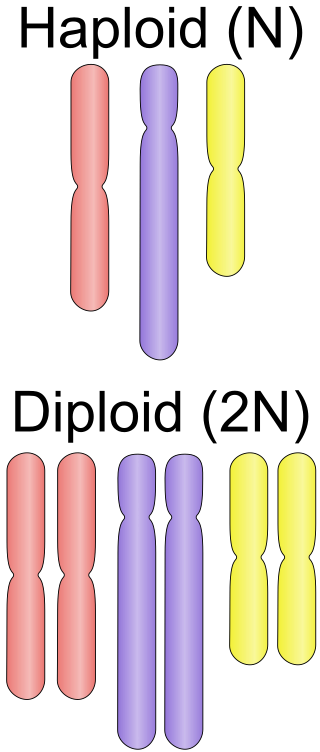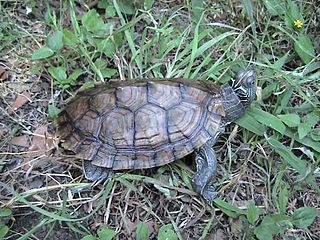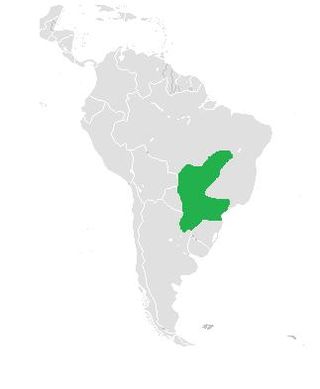
Ploidy is the number of complete sets of chromosomes in a cell, and hence the number of possible alleles for autosomal and pseudoautosomal genes. Sets of chromosomes refer to the number of maternal and paternal chromosome copies, respectively, in each homologous chromosome pair, which chromosomes naturally exist as. Somatic cells, tissues, and individual organisms can be described according to the number of sets of chromosomes present : monoploid, diploid, triploid, tetraploid, pentaploid, hexaploid, heptaploid or septaploid, etc. The generic term polyploid is often used to describe cells with three or more chromosome sets.

The red-eared slider or red-eared terrapin is a subspecies of the pond slider, a semiaquatic turtle belonging to the family Emydidae. It is the most popular pet turtle in the United States, is also popular as a pet across the rest of the world, and is the most invasive turtle. It is the most commonly traded turtle in the world.

Chelidae is one of three living families of the turtle suborder Pleurodira, and are commonly called Austro-South American side-neck turtles. The family is distributed in Australia, New Guinea, parts of Indonesia, and throughout most of South America. It is a large family of turtles with a significant fossil history dating back to the Cretaceous. The family is entirely Gondwanan in origin, with no members found outside Gondwana, either in the present day or as a fossil.

The spotted turtle, the only species of the genus Clemmys, is a small, semi-aquatic turtle that reaches a carapace length of 8–12 cm (3.1–4.7 in) upon adulthood. Their broad, smooth, low dark-colored upper shell, or carapace, ranges in its exact colour from black to a bluish black with a number of tiny yellow round spots. The spotting patterning extends from the head, to the neck and out onto the limbs. Sexually mature males have a concave plastron and a long, thick tail. By contrast, sexually mature females possess a flat plastron and have a tail notable shorter and thinner than mature males. Mature males also have a dark iris and face; females typically have a yellow or orange iris and a similarly coloured face that is distinctly lighter than males. Juveniles appear female-like in this regard and at maturity males begin to develop darker features.

The chicken turtle is a turtle native to the southeastern United States. It is the only extant member of the genus Deirochelys and is a member of the freshwater marsh turtle family Emydidae. The chicken turtle's scientific name refers to its extremely long neck and distinctive net-like pattern on its upper shell. There are three regionally distinct subspecies, which are thought to have evolved when populations became separated during periods of glaciation. These subspecies can be distinguished by their appearance; the western chicken turtle displays dark markings along the seams of its plastron, while the plastron of the Florida subspecies is a bright yellow or orange color. Fossil records show that the chicken turtle has been present in the region for up to five million years.

The African helmeted turtle, also known commonly as the marsh terrapin, the crocodile turtle, or in the pet trade as the African side-necked turtle, is a species of omnivorous side-necked terrapin in the family Pelomedusidae. The species naturally occurs in fresh and stagnant water bodies throughout much of Sub-Saharan Africa, and in southern Yemen.

The red-footed tortoise is a species of tortoise from northern South America. These medium-sized tortoises generally average 30 cm (12 in) as adults, but can reach over 40 cm (16 in). They have dark-colored, loaf-shaped carapaces with a lighter patch in the middle of each scute, and dark limbs with brightly colored scales that range from pale yellow to dark red. Recognized differences are seen between red-footed tortoises from different regions. They are closely related to the yellow-footed tortoise from the Amazon Basin. They are popularly kept as pets, and over-collection has caused them to be vulnerable to extinction.The species name has often been misspelled as carbonaria, an error introduced in the 1980s when Chelonoidis was elevated to genus and mistakenly treated as feminine, an error recognized and fixed in 2017.

The Indian black turtle or Indian pond terrapin is a species of medium-sized freshwater turtle found in South Asia.

The Amboina box turtle or Southeast Asian box turtle is a species of Asian box turtle.

The Indian roofed turtle is a species of turtle in the family Geoemydidae. It can be distinguished by the distinct "roof" at the topmost part of the shell. It is found in the major rivers of South Asia. It is a common pet in the Indian Subcontinent.

The common box turtle is a species of box turtle with six existing subspecies. It is found throughout the Eastern United States and Mexico. The box turtle has a distinctive hinged lowered shell that allows it to completely enclose itself. Its upper jaw is long and curved.

Graptemys is a genus of freshwater turtles containing 14 species, commonly known as map turtles. Graptemys are small to medium-sized turtles that are sexually dimorphic, with females attaining as much as twice the length and ten times the mass as males in some species. Depending on the species, adult males range from 7–16 cm (2.75–6.25 in), adult females 10–29.5 cm (4–11.62 in), and hatchlings 2.5–3.8 cm (1–1.5 in), although some sources indicate female Barbour's map turtles grow to 33 cm (13 in) in length. Most species have a distinctive dark pigmented keel that is often notched or serrated running down the center of the carapace and serrated scutes on the rear margin. The head, neck, and limbs exhibit bold patterns of yellow lines and spots against darker green, olive, or black base colors. The patterns on the head can be important characters in identifying the various species. The common name "map turtle" is derived from the intricate patterns on their shells that are suggestive of topographical maps, although the patterns are more apparent in some species than others, and often become obscure in older specimens. Some species are occasionally called "sawbacks", in reference to the serrated keels on their shell.

The spiny softshell turtle is a species of softshell turtle, one of the largest freshwater turtle species in North America. Both the common name, spiny softshell, and the specific name, spinifera (spine-bearing), refer to the spiny, cone-like projections on the leading edge of the carapace, which are not scutes (scales).

The wood turtle is a species of turtle endemic to North America. It is in the genus Glyptemys, a genus which contains only one other species of turtle: the bog turtle. The wood turtle reaches a straight carapace length of 14 to 20 centimeters, its defining characteristic being the pyramidal shape of the scutes on its upper shell. Morphologically, it is similar to the bog turtle, spotted turtle, and Blanding's turtle. The wood turtle exists in a broad geographic range extending from Nova Scotia in the north to Minnesota in the west and Virginia in the south. In the past, it was forced south by encroaching glaciers: skeletal remains have been found as far south as Georgia.

The Caspian turtle or striped-neck terrapin is a species of turtle in the family Geoemydidae (=Bataguridae), living in the eastern Mediterranean region from southwestern former USSR and central Iran to Saudi Arabia, Bahrain, Israel, and Lebanon, northward through Turkey to Bulgaria, and through Cyprus, Crete, and the Ionian Peninsula to former Yugoslavia.

The big-headed pantanal swamp turtle or pantanal swamp turtle is a species of turtle in the family Chelidae found in Brazil, Bolivia, Argentina, and Paraguay.

The yellow-footed tortoise, also known as the Brazilian giant tortoise, commonly referred to as the Brazilian giant turtle, or more commonly, the big turtle, is a species of tortoise in the family Testudinidae and is closely related to the red-footed tortoise. It is found in the Amazon Basin of South America. The species name has often been misspelled as denticulata, an error introduced in the 1980s when Chelonoidis was elevated to genus and mistakenly treated as feminine, an error recognized and fixed in 2017.

Vanderhaege's toad-headed turtle is a species of turtle in the family Chelidae. The species is endemic to South America.

Siebenrockiella crassicollis is a freshwater turtle endemic to Southeast Asia. It is one of two species classified under the genus Siebenrockiella in the family Geoemydidae.

Cyclemys is a genus of freshwater turtles, commonly referred to as Asian leaf turtles, from the family Geoemydidae. The genus occurs throughout Southeast and South Asia, and currently contains seven species.





















